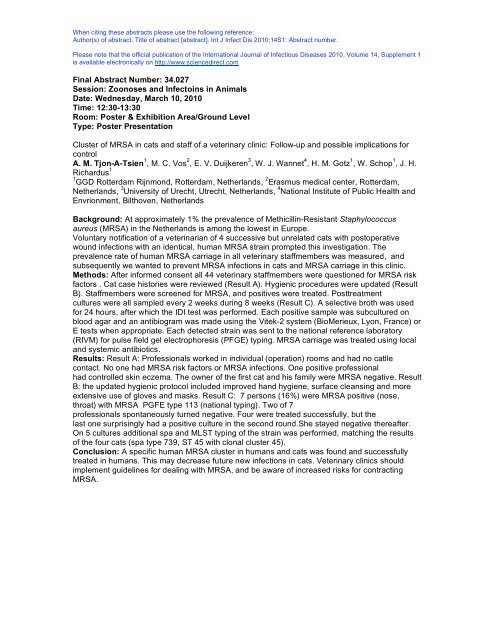14th ICID - Poster Abstracts - International Society for Infectious ...
14th ICID - Poster Abstracts - International Society for Infectious ...
14th ICID - Poster Abstracts - International Society for Infectious ...
You also want an ePaper? Increase the reach of your titles
YUMPU automatically turns print PDFs into web optimized ePapers that Google loves.
When citing these abstracts please use the following reference:<br />
Author(s) of abstract. Title of abstract [abstract]. Int J Infect Dis 2010;14S1: Abstract number.<br />
Please note that the official publication of the <strong>International</strong> Journal of <strong>Infectious</strong> Diseases 2010, Volume 14, Supplement 1<br />
is available electronically on http://www.sciencedirect.com<br />
Final Abstract Number: 34.027<br />
Session: Zoonoses and Infectoins in Animals<br />
Date: Wednesday, March 10, 2010<br />
Time: 12:30-13:30<br />
Room: <strong>Poster</strong> & Exhibition Area/Ground Level<br />
Type: <strong>Poster</strong> Presentation<br />
Cluster of MRSA in cats and staff of a veterinary clinic: Follow-up and possible implications <strong>for</strong><br />
control<br />
A. M. Tjon-A-Tsien 1 , M. C. Vos 2 , E. V. Duijkeren 3 , W. J. Wannet 4 , H. M. Gotz 1 , W. Schop 1 , J. H.<br />
Richardus 1<br />
1 GGD Rotterdam Rijnmond, Rotterdam, Netherlands, 2 Erasmus medical center, Rotterdam,<br />
Netherlands, 3 University of Urecht, Utrecht, Netherlands, 4 National Institute of Public Health and<br />
Envrionment, Bilthoven, Netherlands<br />
Background: At approximately 1% the prevalence of Methicillin-Resistant Staphylococcus<br />
aureus (MRSA) in the Netherlands is among the lowest in Europe.<br />
Voluntary notification of a veterinarian of 4 successive but unrelated cats with postoperative<br />
wound infections with an identical, human MRSA strain prompted this investigation. The<br />
prevalence rate of human MRSA carriage in all veterinary staffmembers was measured, and<br />
subsequently we wanted to prevent MRSA infections in cats and MRSA carriage in this clinic.<br />
Methods: After in<strong>for</strong>med consent all 44 veterinary staffmembers were questioned <strong>for</strong> MRSA risk<br />
factors . Cat case histories were reviewed (Result A). Hygienic procedures were updated (Result<br />
B). Staffmembers were screened <strong>for</strong> MRSA, and positives were treated. Posttreatment<br />
cultures were all sampled every 2 weeks during 8 weeks (Result C). A selective broth was used<br />
<strong>for</strong> 24 hours, after which the IDI test was per<strong>for</strong>med. Each positive sample was subcultured on<br />
blood agar and an antibiogram was made using the Vitek-2 system (BioMerieux, Lyon, France) or<br />
E tests when appropriate. Each detected strain was sent to the national reference laboratory<br />
(RIVM) <strong>for</strong> pulse field gel electrophoresis (PFGE) typing. MRSA carriage was treated using local<br />
and systemic antibiotics.<br />
Results: Result A: Professionals worked in individual (operation) rooms and had no catlle<br />
contact. No one had MRSA risk factors or MRSA infections. One positive professional<br />
had controlled skin eczema. The owner of the first cat and his family were MRSA negative. Result<br />
B: the updated hygienic protocol included improved hand hygiene, surface cleansing and more<br />
extensive use of gloves and masks. Result C: 7 persons (16%) were MRSA positive (nose,<br />
throat) with MRSA PGFE type 113 (national typing). Two of 7<br />
professionals spontaneously turned negative. Four were treated successfully, but the<br />
last one surprisingly had a positive culture in the second round.She stayed negative thereafter.<br />
On 5 cultures additional spa and MLST typing of the strain was per<strong>for</strong>med, matching the results<br />
of the four cats (spa type 739, ST 45 with clonal cluster 45).<br />
Conclusion: A specific human MRSA cluster in humans and cats was found and successfully<br />
treated in humans. This may decrease future new infections in cats. Veterinary clinics should<br />
implement guidelines <strong>for</strong> dealing with MRSA, and be aware of increased risks <strong>for</strong> contracting<br />
MRSA.
















